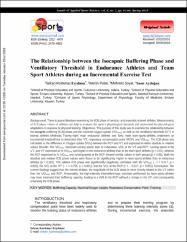| dc.contributor.author | Korkmaz Eryılmaz, Selcen | |
| dc.contributor.author | Polat, Metin | |
| dc.contributor.author | Soyal, Mehmet | |
| dc.contributor.author | Aydoğan, Sami | |
| dc.date.accessioned | 2019-01-22T10:34:34Z | |
| dc.date.available | 2019-01-22T10:34:34Z | |
| dc.date.issued | 2018-05-02 | |
| dc.identifier.issn | 2322-4479 | |
| dc.identifier.issn | 2476-4981 | |
| dc.identifier.uri | http://hdl.handle.net/11363/961 | |
| dc.description.abstract | Background. There is sparse literature examining the ICB phase of aerobic- and anaerobic-trained athletes. Measurements of ICB phase values of athletes can help to evaluate the sport’s physiological demands and understand the physiological adaptations in response to physical training. Objectives. The purpose of this study was to examine the relationship between the isocapnic buffering (ICB) phase and the maximal oxygen uptake (VO2max) as well as the ventilatory threshold (VT) in trained athletes. Methods. Twenty-eight male endurance athletes and forty male team sports athletes underwent an incremental treadmill test to determine their VT, respiratory compensation point (RCP), and VO2max. The ICB phase was calculated as the difference in Oxygen uptake (VO2) between the RCP and VT and expressed in either absolute or relative values. Results. The VO2max, maximal running speed, time to exhaustion, VO2 at the VT and RCP, running speed at the VT, and VT expressed as % VO2max was higher in the endurance athletes than in the team sport athletes (p < 0.01), whereas the RCP expressed as % VO2max and running speed at the RCP showed similar values in both groups (p > 0.05). Both the absolute and relative ICB phase values were found to be significantly higher in team sports athletes than in endurance athletes (p < 0.001). The relative ICB phase was significantly negatively correlated with the VO2max (– r = 0.517, p < 0.001), the VO2 at the VT (– r = 0.755, p < 0.001), and the VO2 at the RCP (r = – 0.517, p = 0.001). Conclusion. The current findings suggest that, for trained athletes, the magnitude of the ICB phase is more closely related to the VT rather than the VO2max and RCP. Presumably, the high-intensity intermittent-type exercises performed by team sports athletes may have improved their buffering capacity, leading to a shift in the RCP without a change in the VT, and consequently enhancing the ICB phase. | en_US |
| dc.language.iso | eng | en_US |
| dc.publisher | Asian Exercise and Sport Science Association | en_US |
| dc.relation.isversionof | 10.29252/aassjournal.6.1.1 | en_US |
| dc.rights | info:eu-repo/semantics/openAccess | en_US |
| dc.rights | Attribution-NonCommercial-NoDerivs 3.0 United States | * |
| dc.rights.uri | http://creativecommons.org/licenses/by-nc-nd/3.0/us/ | * |
| dc.subject | Research Subject Categories::SOCIAL SCIENCES::Social sciences::Social work::Sports research | en_US |
| dc.title | The Relationship between the Isocapnic Buffering Phase and Ventilatory Threshold in Endurance Athletes and Team Sport Athletes during an Incremental Exercise Test | en_US |
| dc.type | article | en_US |
| dc.relation.ispartof | Annals of Applied Sport Science | en_US |
| dc.department | İstanbul Gelişim Üniversitesi | en_US |
| dc.identifier.volume | 6 | en_US |
| dc.identifier.issue | 1 | en_US |
| dc.identifier.startpage | 1 | en_US |
| dc.identifier.endpage | 9 | en_US |
| dc.relation.publicationcategory | Kategori Yok | en_US |



















